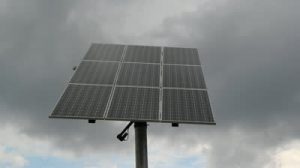by James A. Bacon
Governor Terry McAuliffe has announced yet another utility-scale solar deal, this one a 20-megawatt project in Cape Charles in Northampton County. The “Cherrydale Project” will generate enough energy to power more than 3,000 households throughout the region, states the governor’s press release.
The project was assembled by a newcomer to the Virginia solar scene: Chicago-based Hecate Energy LLC.
“As a Virginia native with family ties to the Eastern Shore region, the 20-megawatt Cherrydale solar development has been an exciting and gratifying project with which to be involved,” said Preston Schultz, Hecate’s director of development. “We are grateful to Northampton County for their support throughout the development of the Cherrydale Project.”
A quick perusal of the Internet revealed that Hecate’s request for a special use permit ran into local opposition from residents who opposed the loss of 150 prime acres of farmland in land zoned for agricultural use. On the positive side, according to the Cape Charles Mirror, the project is expected to generate $750,000 in real estate taxes over 35 years, while Hecate offered $200,000 in a “community improvement grant” for Northampton County to use as it wished.
The “permit by rule” issued by the Virginia Department of Environmental Quality contains provisions to ensure that the environment is protected at the Cape Charles site.
“In my opinion, the Commonwealth of Virginia Permit by Rule process strikes the right balance between protecting critical local environmental, cultural and historical resources while at the same time providing opportunities for the new clean energy economy to take root and flourish in the Old Dominion,” Schultz said in the press release.
The 185-acre facility will utilize an “innovative tracking system,” noted the press release, that maximizes energy output from the available sunlight. The facility will interconnect with the Old Dominion Electric Cooperative and A&N Electric Cooperative system.
Bacon’s bottom line: After a slow start, utility-scale solar is taking off in Virginia. As usual, however, the governor’s press release doesn’t provide the data that allows us to calculate the cost-per-kilowatt of the up-front capital investment, much less how the levelized cost (cost of construction, financing, operation and fuel over time) compares to other energy alternatives.
We don’t even know who Hecate will sell the electricity to. The fact that the solar plant will interconnect with two Eastern Shore electrical cooperatives does not tell us who will ultimately buy that electricity. Will it be sold into the PJM wholesale market? Has an Amazon Web Services-like buyer contracted to purchase the power? Will ratepayers of the local electrical co-ops purchase the power?
The deal may be great, it may be a dog. We don’t know, and if other solar deals are any indication, the terms and economics of this one will not be released to the public — although, I must be clear, I have not asked Hecate for details.
Speaking generally, not of this deal in particular, the lack of transparency invites suspicion. If the economics of Virginia’s solar deals were beneficial to ratepayers, one might reason, the players involved would be eager to share the news. The fact that the information is not shared suggests that they have something to hide. I hope my suspicions are unfounded. But the deal makers could dispel them easily by making more information available.



